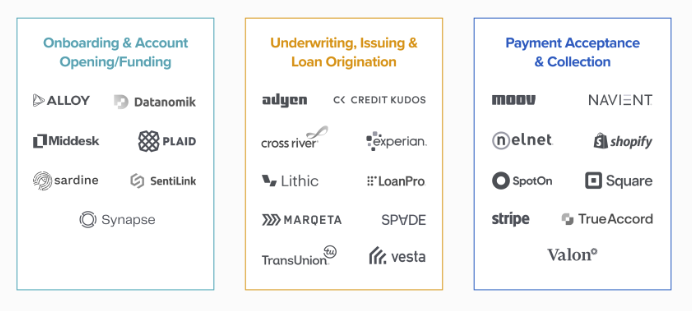This week a look at Fintech strategy and their approach to embedded finance, a very stilted view that branches play in banking, and the effects of regulatory and competitive pressure on overdraft fees.
1. Advice to Fintechs
Marc Andrusko and Angela Strange of VC firm a16z write on the foundation for successful fintech infrastructure. In addition to laying what they see of the entry paths for new starting companies, their advice drives forward the notion that “every company will become a fintech company.” With some form of embedded finance capability becoming more prevalent in “non-finance” companies, they examine the approach of 2 competing KYC offerings:
Consider here the difference in approach of Persona vs. Socure, two companies operating in the KYC space. For the ambitious developer seeking to build a fully customizable identity verification experience as part of their company’s onboarding flow, Persona markets “building block” and “mix and match” capabilities all over its homepage (see image below), while highlighting “Try it now” as the main call to action and providing a “Developers” hub with links to API documentation and a status dashboard. Socure, on the other hand, runs a more business-oriented go-to-market approach, in which the product is often referred to as a “platform” and the main call to action is always to “Request a demo & pricing,” aka, talk to sales.
Additionally, their advice for areas ripe for disruption from traditional banking and finance is in “mission critical” finops:
Would your customers be materially disrupted (or even forced to halt operations) if your service went down? Or are you merely a nice-to-have? The answers to these questions directly determine the pricing power, defensibility, and overall stickiness of your product. The deeper you’re embedded—and oftentimes, the stricter your uptime SLAs!—the harder it is to replace you. While certainly not all successful infrastructure businesses will become 100% mission critical, we believe it’s easier to drive higher customer LTV when the core service you provide is absolutely essential to day-to-day operations.

2. The cynical view of branch operations
Patrick McKenzie of Stripe writes a very pointed piece on exactly what purpose and economic value bank branches have.
Bank branches are sales offices You probably mostly think of bank branches in terms of tellers, ATMs, and routine transactions. This is not why bank branches exist; it is an incidental offering of the bank to secure your business.
Bank branches exist to sell new accounts. They are sited to maximize new accounts and the value of those accounts. They are staffed to maximize new accounts and cross-sells to existing customers (which will often be called “relationships” at a bank). Everything down to the physical layout of branches and sometimes even the relative paucity of non-branch options (“channels” in the lingo, like phone or online banking) is designed to maximize new accounts….
If you’ve ever wondered why you were ambushed upon walking in and directed to a banker for something you’d normally do at the teller window or ATM, sales quotas are why. Bankers have a script to read to see if your needs have changed recently. If they aren’t aggressive enough about sourcing business, from people walking in the door or from calling existing customers or new prospects, they will be replaced with someone who can meet their quotas.
This quick sketch of the realities of incentives at bank branches should suggest a good analogue for you: while a branch might have the professional vibe of a doctor’s office or be opposite the street from a fast food restaurant, the business it is closest to in character is actually a cell phone store. It’s a high pressure sales environment, with most of the sales professionals not exactly being industry experts, where substantially all of the money is made “on the backend” (over time) of service delivery lasting many years.
While Patrick can be excused for making a few generalizations, he asserts that there is no opportunity or effort being made in bank branches beyond account opening. Additionally, he believes the experience fails to provide any value to either customers or banks. If you’re reading this, I expect you have a strong opinion about that. This view ignores the position of trust community banks and credit unions still hold, elevated by deep-seated mistrust of Big Tech. Please drop us a line if this hot take didn’t sit well.
3. Overdraft fees dropping
Megan Leonhardt of Fortune reports on the continued industry-wide decline in overdraft fees as a source of revenue for banks.
The average cost of an overdraft fee fell by 11%, dropping from a record high of $33.58 in 2021 to $29.80 this year, according to Bankrate.com’s annual Checking Account and ATM Fee Study released Wednesday. Still the most common price for overdraft fees remains at about $35, the same as it’s been for the last 13 years.
The average non-sufficient funds (NSF) fee—similar to an overdraft fee and typically assessed when customers overdraw their checking account with a check or recurring charge like a rent or bill payment—is down 21% year over year. These fees hit an average cost of $26.58 this year, the lowest level recorded since 2004.
While some consumers are saving more as bigger banks get rid of these fees, these charges are still widely levied. In its survey of 245 financial institutions offering consumer checking accounts, Bankrate found that 96% of checking accounts charge overdraft fees and 87% assess NSF fees.
One reason for the slow pace of change across the industry: overdraft and NSF fees are a big revenue driver for financial institutions. In 2021, banks, credit unions, community banks, and fintechs earned an estimated $33.4 billion off these types of fees, according to economic research company Moebs Services.
This is another data point in the pressure on non-interest income and the need to identify other offerings, services, and products to maintain long-term margins for your org.
That’s it for this week and the start of fall. Even after a short week, I’m ready to sleep like a squirrel monkey. Let us know how we’re doing for you at blog@mindspaninc.com. And if you’re not too tired, share below.

